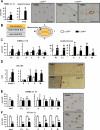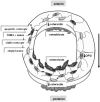Cell autonomous requirement of connexin 43 for osteocyte survival: consequences for endocortical resorption and periosteal bone formation
- PMID: 22028311
- PMCID: PMC3271138
- DOI: 10.1002/jbmr.548
Cell autonomous requirement of connexin 43 for osteocyte survival: consequences for endocortical resorption and periosteal bone formation
Abstract
Connexin 43 (Cx43) mediates osteocyte communication with other cells and with the extracellular milieu and regulates osteoblastic cell signaling and gene expression. We now report that mice lacking Cx43 in osteoblasts/osteocytes or only in osteocytes (Cx43(ΔOt) mice) exhibit increased osteocyte apoptosis, endocortical resorption, and periosteal bone formation, resulting in higher marrow cavity and total tissue areas measured at the femoral mid-diaphysis. Blockade of resorption reversed the increased marrow cavity but not total tissue area, demonstrating that endocortical resorption and periosteal apposition are independently regulated. Anatomical mapping of apoptotic osteocytes, osteocytic protein expression, and resorption and formation suggests that Cx43 controls osteoclast and osteoblast activity by regulating osteoprotegerin and sclerostin levels, respectively, in osteocytes located in specific areas of the cortex. Whereas empty lacunae and living osteocytes lacking osteoprotegerin were distributed throughout cortical bone in Cx43(ΔOt) mice, apoptotic osteocytes were preferentially located in areas containing osteoclasts, suggesting that osteoclast recruitment requires active signaling from dying osteocytes. Furthermore, Cx43 deletion in cultured osteocytic cells resulted in increased apoptosis and decreased osteoprotegerin expression. Thus, Cx43 is essential in a cell-autonomous fashion in vivo and in vitro for osteocyte survival and for controlling the expression of osteocytic genes that affect osteoclast and osteoblast function.
Figures






References
-
- Klein-Nulend J, Bonewald LF. The osteocyte. In: Bilezikian JP, Raisz LG, Martin TJ, editors. Principles of Bone Biology. Third ed. Academic Press; San Diego, CA: 2008. pp. 153–174.
-
- Paszty C, Turner CH, Robinson MK. Sclerostin: a gem from the genome leads to bone-building antibodies. J Bone Miner Res. 2010;25:1897–1904. - PubMed
-
- Zhao S, Zhang YK, Harris S, Ahuja SS, Bonewald LF. MLO-Y4 osteocyte-like cells support osteoclast formation and activation. J Bone Miner Res. 2002;17:2068–2079. - PubMed
Publication types
MeSH terms
Substances
Grants and funding
- UL1 RR025761/RR/NCRR NIH HHS/United States
- K02-AR02127/AR/NIAMS NIH HHS/United States
- S10-RR023710/RR/NCRR NIH HHS/United States
- P01 AG013918/AG/NIA NIH HHS/United States
- IK6 BX004596/BX/BLRD VA/United States
- S10 RR023710/RR/NCRR NIH HHS/United States
- R01 DK076007/DK/NIDDK NIH HHS/United States
- K02 AR002127/AR/NIAMS NIH HHS/United States
- R01-AR053643/AR/NIAMS NIH HHS/United States
- P01-AG13918/AG/NIA NIH HHS/United States
- R01 AR059357/AR/NIAMS NIH HHS/United States
- R03 TW006919/TW/FIC NIH HHS/United States
- R01-DK076007/DK/NIDDK NIH HHS/United States
- R01 AR053643/AR/NIAMS NIH HHS/United States
- RR025761/RR/NCRR NIH HHS/United States
LinkOut - more resources
Full Text Sources
Molecular Biology Databases

